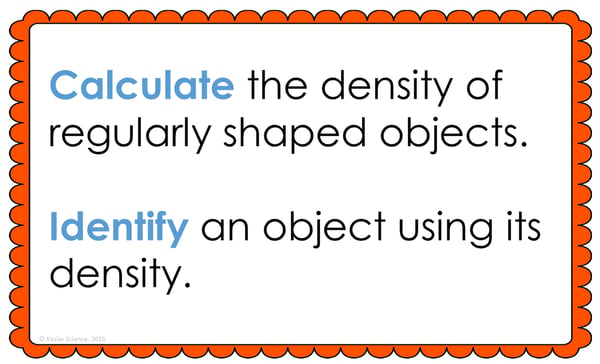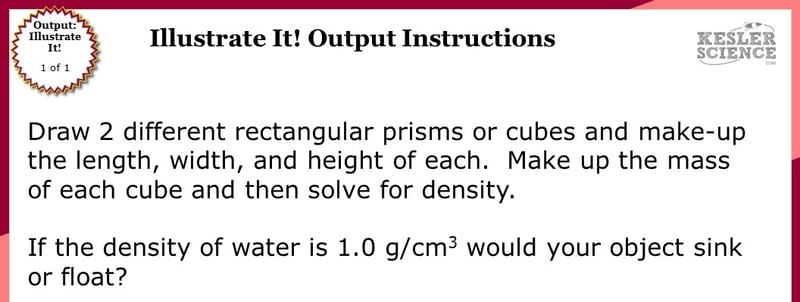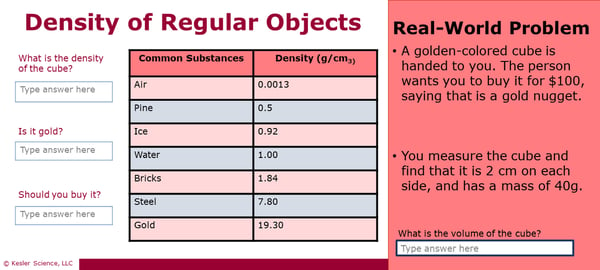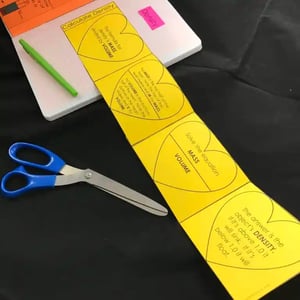Density of a Regular-Shaped Object Lesson Plan - A Complete Science Lesson Using the 5E Method of Instruction
By the end of this lesson about the density of a regular-shaped object, students will be able to calculate the density of regularly shaped objects and identify an object using its density. Each of our lessons is designed using the 5E method of instruction to ensure maximum comprehension by the students. This well-thought out unit does the heavy lifting, giving teachers easy-to-implement, highly engaging lesson plans.
This blog will walk you through each of the steps and activities from the Density of a Regular-Shaped Object 5E Lesson Plan.
ENGAGEMENT
Objective Introduction
At the beginning of the lesson, the class will do a Think-Pair-Share to discuss the objective.
Class Activity
- Give each group of students two pennies. One pre-1982 and one post-1982.
- Tell them that each coin is very different from the other.
- Ask students to brainstorm ways to determine how the coins are different.
- Discuss their ideas and lead the discussion toward measuring the mass and volume of the pennies.
Student Activity
- Watch the YouTube Video “Melting Pennies” – https://goo.gl/dA1ur4 (case-sensitive)
- Explain that over the next few days, students will be learning about the density of regular-shaped objects like metal bars or blocks of wood.

The teacher will then help to clear any misconceptions their students might have about the density of regular-shaped objects. A common but major misconception, for example, is that they'll often think of an object's density and weight as being the same thing.
Estimated Class Time for the Engagement: 20-30 minutes
EXPLORATION
With nine stations in total, you can introduce the density of regularly-shaped objects to your middle school students in a variety of ways! Four of these stations are considered input stations where students will learn new information about an object's density, and four of the stations are output stations where students will be demonstrating their mastery of the lesson's material. A bonus station offers challenges for your early finishers and independent learners. You can read more about how I set up the station labs here.
Watch It!
At this station, students will be watching a short video explaining five facts about density. Students will then answer some questions relating to the video and record their answers on their lab station sheet. For example: Why does the diet cola float while the regular cola sinks? Why do hot air balloons float? Why does the density of an object not change when you change the shape of it?
Read It!
This station will provide students with a one-page reading about density. In the reading, students will learn about how density affects whether or not an object will sink or float in a fluid. Students will also learn the proper way to determine the density of objects. There are four follow-up questions that the students will answer to demonstrate their comprehension of the reading material.
Explore It!
Students will be working in pairs to better understand how to calculate the density of regular-shaped objects. Students will use a triple beam balance, and a ruler to determine the volume and mass of those objects. Students will use this information to determine the density of the objects. Students can then guess if those objects will sink or float in a liquid.
Research It!
The research station will allow students to interact with a simulation and hypothesize whether or not objects will sink or float. Students will be directed to follow steps on the task cards that will have them focus their attention to learn how to determine whether objects will sink or float in the simulation.
Organize It!
The Organize It station allows your students to organize four different regular-shaped objects with their densities. Students will use the mass and volumes given to determine which correct density card to match up with.
Illustrate It!
Your visual students will love this station. Students will draw two different rectangular prisms or cubes and make up the length, volume, and width of both. Students will also make up the mass of each cube that will help them to calculate their densities.

Write It!
Students who can answer open-ended questions about the lab truly understand the concepts that are being taught. At this station, the students will be answering three task cards: Explain in your words how you would find the density of a regular-shaped object. What is density? Why would it be important for geologists to know the density of certain rocks and minerals?
Assess It!
The Assess It station is where students will go to prove mastery over the concepts they learned in the lab. The questions are set up in a standardized format with multiple choice answers. Some questions students will be asked are: What is the density of an object with a mass of 72 g? What is the density of an object with a mass of 81 g? What is the mass of an object with a volume of 1 cm3 and density of 8 g/cm3? What is the volume of an object that has a mass of 24 g and density of 8 g/cm3?
Challenge It! - Bonus Station
Early finishers and advanced students will love the extension activities in this station. Four activity choices offer them ways to expand their learning through mini-games and mini-projects.
Estimated Class Time for the Exploration: One or two 45-minute class periods
EXPLANATION
The elaboration section of the 5E method of instruction gives students choices that allow them to prove they’ve mastered the concepts behind the lesson. When students are given a choice, they’re much more enthusiastic and invested in the project than they are when their teachers choose their projects for them. There are a total of nine choices to demonstrate understanding of density of a regular-shaped object. A separate set of choices that offer more teacher support are also available for students that need them. Rubrics guide students to doing their best work and assist in grading.


Interactive notebook samples: Above-left is a digital INB activity slide; above-right is an example of the paper INB activities.
The students will also be interacting with their journals using INB templates for the density of regular-shaped objects. Each INB activity is designed to help students compartmentalize information for a greater understanding of the concept. The density of regular-shaped objects INB templates allows students to focus their notes on the definition of density, Archimedes, how you can tell if an object will sink or float in water.
Estimated Class Time for the Exploration: Two or three 45-minute class periods
ELABORATION
The elaboration section of the 5E method of instruction gives students choices that allow them to prove they’ve mastered the concepts behind the lesson. When students are given a choice, they’re much more enthusiastic and invested in the project than they are when their teachers choose their projects for them. There are a total of nine choices to demonstrate understanding of the density of regular-shaped objects. A separate set of choices that offer more teacher support are also available for students that need them. Rubrics guide students to doing their best work and assist in grading.

Estimated Class Time for the Elaboration: Two or three 45-minute class periods (can also be used as an at-home project)
EVALUATION
The final piece of the 5E model is to evaluate the students' comprehension. Included in every 5E lesson is a homework assignment, assessment, and modified assessment. Research has shown that homework needs to be meaningful and applicable to real-world activities in order to be effective. When possible, I like to give open-ended assessments to truly gauge the student’s comprehension.
Estimated Class Time for the Elaboration: One 45-minute class period
DOWNLOAD THE FULL LESSON NOW
Download Over $100 in FREE Resources
For Middle School Science
Simply create a login below and gain immediate access to a selection of our Kesler Science product line worth $100 - for FREE. There's a full version of every product type! You'll also join tens of thousands of middle school science teachers who receive timely tips and strategies straight to their inbox.







